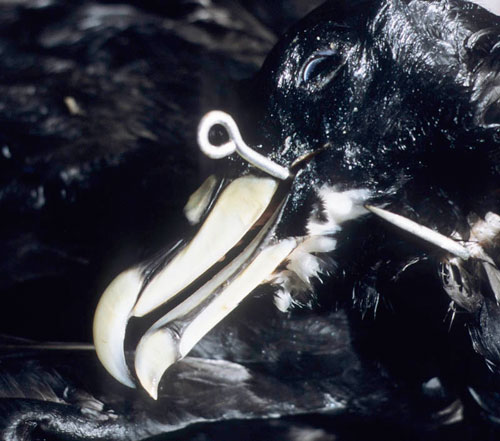Leandro Bugoni, Kate Griffiths and Robert Furness publishing on-line in the Journal of Ornithology have looked at skewed sex ratios in albatrosses and petrels killed by longline fisheries.
The paper's abstract follows:
"Skewed adult sex ratio (ASR) has been proposed as a common pattern in birds, frequently biased towards males and with larger biases in globally threatened species. In albatrosses and petrels, it has been suggested that differential mortality of one gender in fisheries is caused either by sexual size dimorphism giving males a competitive advantage, which allows more access of the larger sex (i.e. males) to discards and/or baits, or to at sea segregation of sexes. Here, we tested these hypotheses by determining ASRs in albatrosses and petrels trapped at sea when attending longline fishing vessels for discards in the southwestern Atlantic Ocean, and searched in the literature for patterns in ASR in albatrosses and petrels killed by fisheries in this area and elsewhere. We show that skewed ASR is common in albatrosses and petrels in the community attending vessels for discards, confirming results found for birds in general. There was no correlation between skewed ASR and conservation status, or between ASR and sexual size dimorphism. Our review of the sex of birds incidentally killed in fisheries found skewed ASR toward males, females or parity to be equally reported. Thus, sexual dimorphism in size does not explain skewed ASR in the community we sampled or in incidental captures in fisheries in the review. Differential at-sea distribution of sexes appears to be a better explanation of the patterns found in the community sampled at sea as well as skewed ASR in seabird fatalities, particularly distant from breeding areas."

Reference:
Bugoni, L., Griffiths, K. & Furness, R.W. 2010. Sex-biased incidental mortality of albatrosses and petrels in longline fisheries: differential distributions at sea or differential access to baits mediated by sexual size dimorphism? Journal of Ornithology DOI: 10.1007/s10336-010-0577-x.
John Cooper, ACAP Information Officer, 11 January 2011

 English
English  Français
Français  Español
Español